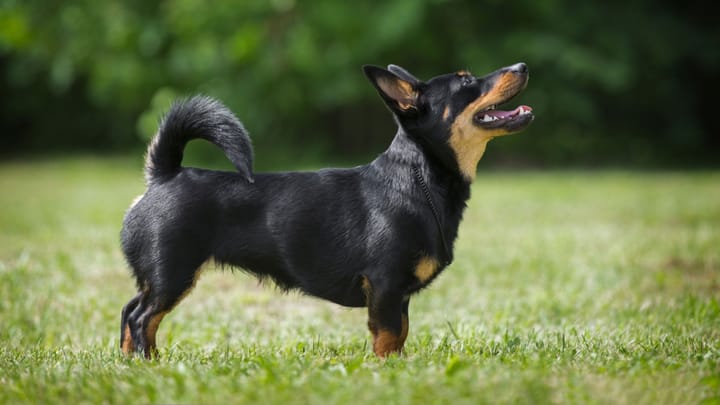Lancashire Heeler

The Lancashire Heeler is a small breed of dog originating from the United Kingdom, primarily bred for herding. Despite its compact size, it is known for its energy, intelligence, and affectionate nature, while retaining a protective instinct that makes it an excellent guard dog. This intelligent breed thrives on human companionship and is eager to please.
|
Life expectancy |
The Lancashire Heeler has a life expectancy of between 12 and 15 years |
|
Temperament |
|
|
Size |
Small
|
|
Adult size |
Female
Between 9 and 11 in
Male
Between 10 and 12 in
|
|
Adult weight |
Female
Between 7 and 13 lb
Male
Between 11 and 13 lb
|
|
Coat colour
|
Black Brown Red |
|
Type of coat
|
Short Hard |
|
Eye colour
|
Brown
|
|
Purchase price |
The Lancashire Heeler costs between £1650 and £2300 |
The Lancashire Heeler is an intelligent, energetic breed that excels in activities such as agility, flyball, and herding trials. Its natural athleticism and quick learning ability make it well-suited to these sports. Additionally, it’s a loyal and affectionate companion, forming strong bonds with its family. Though lively and independent, regular exercise and mental stimulation are key to keeping this breed happy and well-behaved. Its versatility makes it suitable for a range of tasks, both in work and play.
More details about the Lancashire Heeler
Lancashire Heeler: Origins and history
The Lancashire Heeler originated in the UK, specifically in the Lancashire region of England. This breed was developed in the 17th century to assist farmers in driving livestock over long distances and hunting pests. A descendant of crosses between Welsh Corgis and Terriers, It combines the agility of Terriers with the herding skills of Corgis. It has since become a versatile dog, valued not only for its work with livestock but also for its ability to adapt to a range of agricultural tasks.
FCI classification of the Lancashire Heeler
-
Group 1 - Sheepdogs and Cattledogs (except Swiss Cattledogs)
-
Section 2 : Cattledogs (except Swiss Cattledogs)
Lancashire Heeler: Characteristics
Lancashire Heeler: Behaviour
Training a Lancashire Heeler
Training a Lancashire Heeler is most effective with positive reinforcement, such as praise and rewards. They learn quickly, from basic commands to complex behaviours, but can be stubborn, so patience is important. Early socialisation is vital, as they may be wary of strangers. Exposure to various people, animals, and environments helps them adapt. Obedience classes and regular interaction are recommended to develop a confident, well-rounded dog.
Lancashire Heeler: Lifestyle
Breed compatibility Lancashire Heeler
Lancashire Heeler: Purchase price
The price of a Lancashire Heeler in the UK typically ranges from £1,650 to £2,300, depending on the pedigree, location and breeder.
Daily costs for a Lancashire Heeler include food, along with additional expenses for toys, grooming, and veterinary care. Regular exercise and mental stimulation should also be factored into the overall cost of caring for this active breed.
Lancashire Heeler: Shedding
Average
The Lancashire Heeler sheds moderately, especially during seasonal changes, but its short, smooth coat is relatively low-maintenance.
Lancashire Heeler: Grooming
Due to its short, smooth coat with an undercoat, the Lancashire Heeler doesn't require special grooming. However, weekly brushing is recommended to remove dead hair, particularly during shedding periods, helping to keep the coat healthy and minimise loose fur around the home. Regular grooming also allows for early detection of skin issues or parasites.
Lancashire Heeler: Health
The Lancashire Heeler has a strong bone structure and well-developed muscles, contributing to its robustness. Described as both powerful and agile, it is capable of participating in various physical activities.
While the Lancashire Heeler has a short, smooth coat that helps keep it dry, it does not offer sufficient protection against high temperatures. It can tolerate moderate heat but is vulnerable to excessive warmth.
The breed can withstand cooler temperatures but is not suited for extreme cold. Prolonged exposure to low temperatures can make it susceptible to cold-related issues.
The Lancashire Heeler may be prone to weight gain if not exercised adequately or if given an inappropriate diet.
Generally a hardy breed, the Lancashire Heeler can be prone to eye problems, such as lens luxation, and joint disorders. Regular veterinary check-ups are recommended for early detection.
- Hip Dysplasia: malformation of the hip joint, leading to abnormal wear and pain
- Elbow Dysplasia: a similar issue affecting the elbows, where the bones do not fit together properly
- Progressive Retinal Atrophy (PRA): an inherited eye disease that causes progressive deterioration of retinal cells
- Primary Lens Luxation (PLL): displacement of the lens, potentially leading to vision loss
- Collie Eye Anomaly (CEA): a congenital eye malformation that can affect vision
- Patellar Dislocation: displacement of the kneecap from its normal position






